View in other NatureServe Network Field Guides
NatureServe
Montana
Utah
Wyoming
Idaho
Wisconsin
British Columbia
South Carolina
Yukon
California
New York
White Bass - Morone chrysops
General Description
The white bass is an introduced, recent, and infrequent resident of Montana found only in the Missouri River below Fort Peck Dam and the very lower end of the Yellowstone River. These fish are upstream migrants from Lake Sakakawea in North Dakota where they were stocked. They are characterized by a spiny dorsal fin and horizontal stripes. They are spring, broadcast spawners, seldom exceed 1 pound in weight, and of little consequence in Montana fishery management. In other states they are important game fish.
Diagnostic Characteristics
Silvery with six to nine dark, narrow stripes on side. Eye tinted with yellow.
Species Range
Montana Range
Range Descriptions
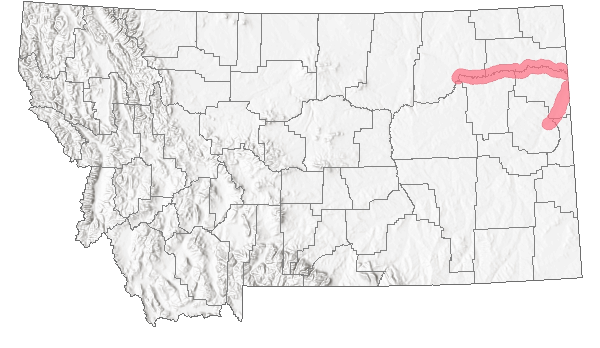
 Non-native
Non-native
Observations in Montana Natural Heritage Program Database
Number of Observations: 23
(Click on the following maps and charts to see full sized version)
Map Help and Descriptions
Relative Density
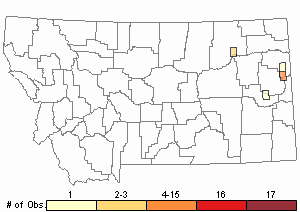
Recency
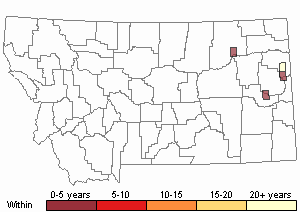
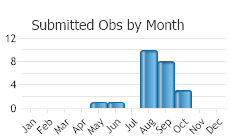
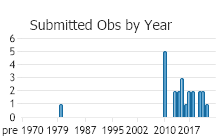
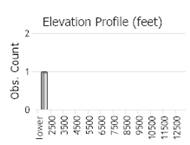 (Observations spanning multiple months or years are excluded from time charts)
(Observations spanning multiple months or years are excluded from time charts)
Migration
Commonly a large spawning migration into tributary streams.
Habitat
Open surface waters of lakes, reservoir,and pools in streams. Avoid turbid water and is most often found over firm sandy or rocky bottom. Spawns over gravelly or rocky bottom on lake shoals or tributary streams.
Food Habits
Young eat small crustaceans and insect larvae. Adults are largely fish-eaters with aquatic insects and crustaceans also taken.
Ecology
Schooling Species.
Reproductive Characteristics
Spawns May - June over a period of 5-10 days at 58-70 degrees F. Spawns in schools. Eggs broadcast and hatch in 46 hours at 60 degrees F. No parental care. Sexually mature in about 3 years in lake Erie.
Management
Stewardship Responsibility
References
- Additional ReferencesLegend:
 View Online Publication
View Online Publication
Do you know of a citation we're missing? Gould, W.R. 1981. First records of the rainbow smelt (Osmeridae), sicklefin chub (Cyphnidae), and white bass (Percichthyidge) from Montana. Proc. MT. Acad. Sci. 40:9-10.
Gould, W.R. 1981. First records of the rainbow smelt (Osmeridae), sicklefin chub (Cyphnidae), and white bass (Percichthyidge) from Montana. Proc. MT. Acad. Sci. 40:9-10. Joslin, Gayle, and Heidi B. Youmans. 1999. Effects of recreation on Rocky Mountain wildlife: a review for Montana. [Montana]: Montana Chapter of the Wildlife Society.
Joslin, Gayle, and Heidi B. Youmans. 1999. Effects of recreation on Rocky Mountain wildlife: a review for Montana. [Montana]: Montana Chapter of the Wildlife Society. Olson, N. W. 2004. Interactions among hybrid Striped Bass, White Bass, and Walleye in Harlan County Reservoir. M.Sc. Thesis. Bozeman, Montana: Montana State University. 58 p.
Olson, N. W. 2004. Interactions among hybrid Striped Bass, White Bass, and Walleye in Harlan County Reservoir. M.Sc. Thesis. Bozeman, Montana: Montana State University. 58 p. Young, B.A., T.L. Welker, M.L. Wildhaber, C.R. Berry, and D. Scarnecchia (eds). 1997. Population structure and habitat use of benthic fishes along the Missouri and Lower Yellowstone Rivers. 1997 Annual report of Missouri River Benthic Fish Study PD-95-5832 to U.S. Army Corps of Engineers and U.S. Bureau of Reclamation. 207 p.
Young, B.A., T.L. Welker, M.L. Wildhaber, C.R. Berry, and D. Scarnecchia (eds). 1997. Population structure and habitat use of benthic fishes along the Missouri and Lower Yellowstone Rivers. 1997 Annual report of Missouri River Benthic Fish Study PD-95-5832 to U.S. Army Corps of Engineers and U.S. Bureau of Reclamation. 207 p.
- Web Search Engines for Articles on "White Bass"
- Additional Sources of Information Related to "Fish"





